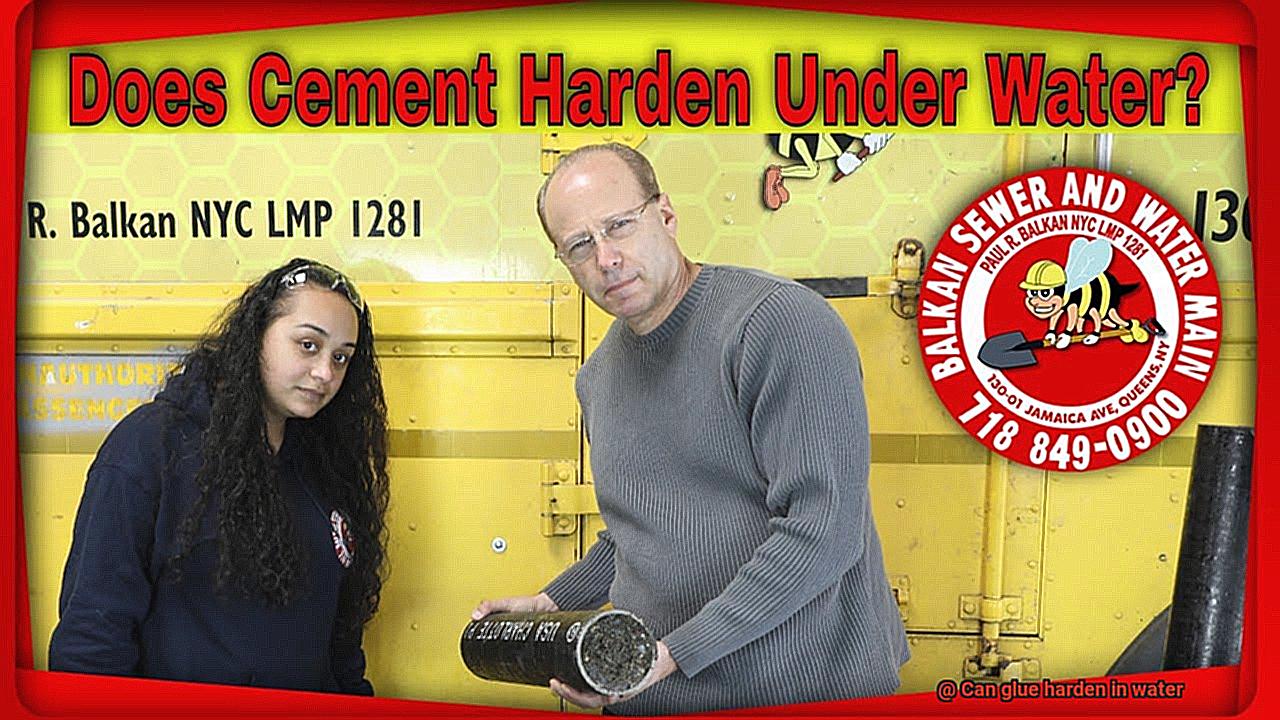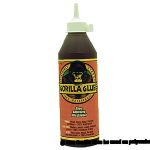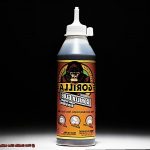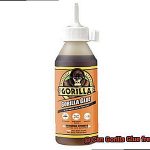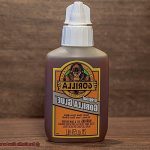Ever spilled water on something you just glued together and wondered if it would hold? We’ve all been there. Glue is like the superhero of DIY projects and fixes, but its relationship with water can be a real head-scratcher.
In this blog post, we’re diving into the nitty-gritty of glue and its reaction to water. Whether you’re a crafting fanatic, a student working on a project, or just someone curious about everyday science, understanding how glue behaves in water is both fascinating and useful.
Forget what you thought you knew about glue drying in the air. When water gets involved, things get interesting. It turns out that water actually speeds up the hardening process of certain glues. This phenomenon, called water-activated adhesion, is like magic for your sticky situations.
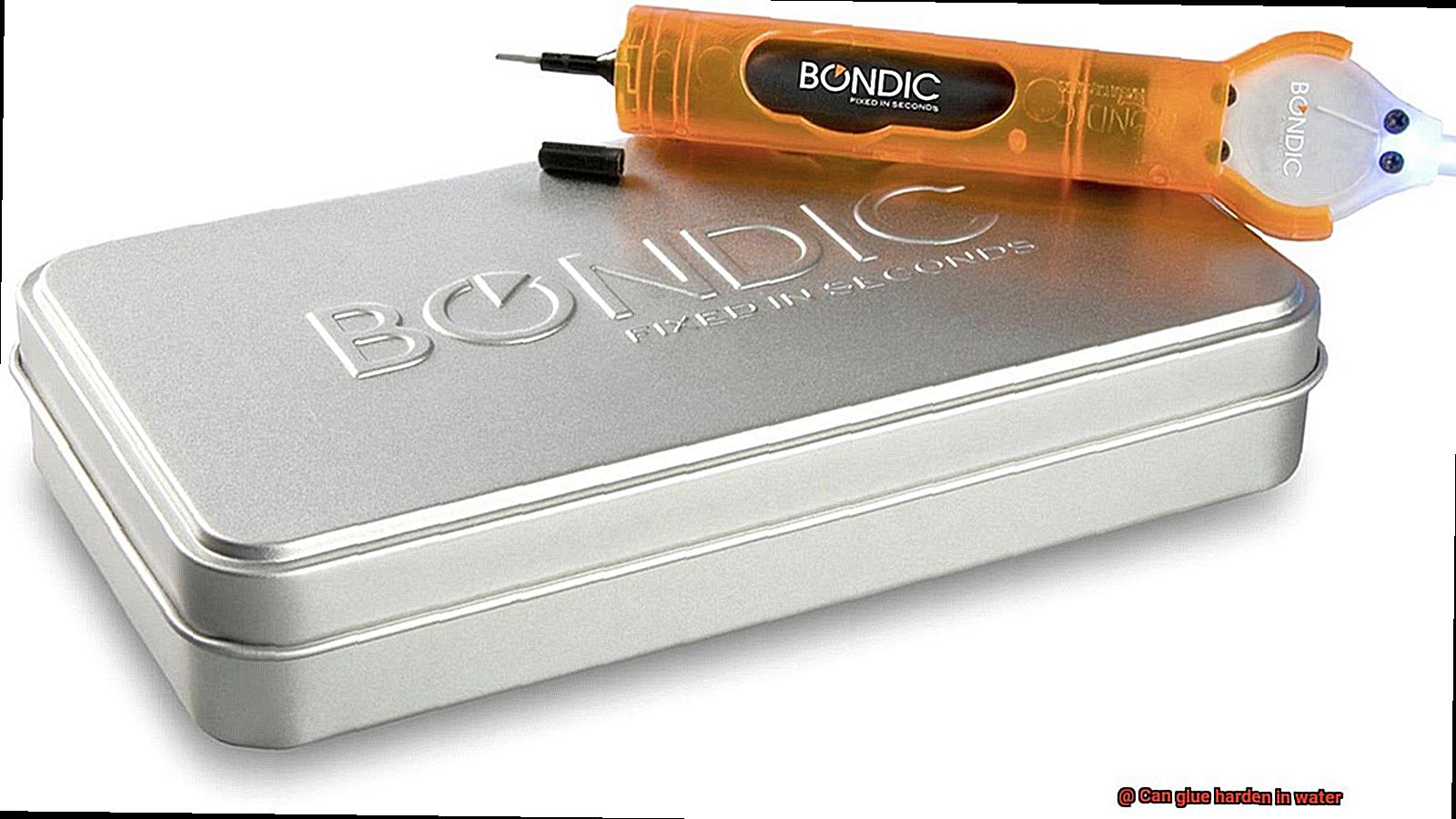
We’ll take a closer look at the different types of glues that react with water and uncover the science behind it all. We’ll also explore what happens when glue meets water – from drying time to strength and durability. And don’t worry – we’ve got practical tips for using glue effectively when dealing with H2O.
So whether you’re worried about your glued masterpiece surviving a splash or looking for ways to make your glue stickier underwater (yes, really), this blog post has got you covered. Join us on this adventure as we unravel the mysteries of glue and water together – because sometimes even superheroes need a little help in wet situations.
How Does Water Affect Glue?
Contents
- 1 How Does Water Affect Glue?
- 2 Types of Glues and Their Different Properties
- 3 Water-Resistant Glues: What Are They and How Do They Work?
- 4 Advantages of Using Water-Resistant Glues
- 5 Disadvantages of Using Water-Resistant Glues
- 6 Tips for Choosing the Right Water-Resistant Glue
- 7 Common Uses for Water-Resistant Glue
- 8 Safety Precautions When Working with Water-Resistant Glue
- 9 Conclusion
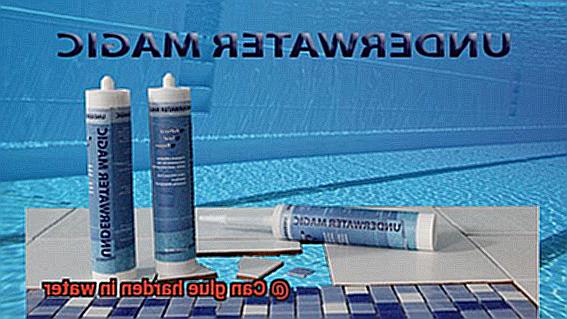
Glue is a versatile adhesive that we rely on for various projects, from arts and crafts to construction. But what happens when water enters the equation? How does water affect glue? In this article, we will delve into the intriguing science behind the interaction of water with different types of glue.
Understanding the Composition of Glue:
To comprehend how water affects glue, it is crucial to understand its composition. Glue consists of polymers, long chains of molecules that provide its adhesive properties. These polymers can be either natural or synthetic, depending on the type of glue.
The Power of Water-Soluble Glues:
Certain glues are water-soluble, meaning they can dissolve or weaken when exposed to water. Water acts as a solvent, breaking down the molecular bonds within the glue’s polymer chains. This weakening effect can be advantageous in situations where objects need to be separated or when removing glue residue is necessary.
The Resilience of Water-Resistant and Waterproof Glues:
In contrast, there are glues specifically designed to resist water or even harden in its presence. These glues include additives or chemicals that make them less susceptible to the effects of water. They are commonly used in applications where exposure to moisture or water is expected, such as outdoor projects or plumbing repairs.
The Impact on Adhesive Properties:
For water-soluble glues, exposure to water can break down the polymer chains, compromising the adhesive strength between glued surfaces. This emphasizes the importance of avoiding excessive moisture or prolonged contact with liquids for such glues.
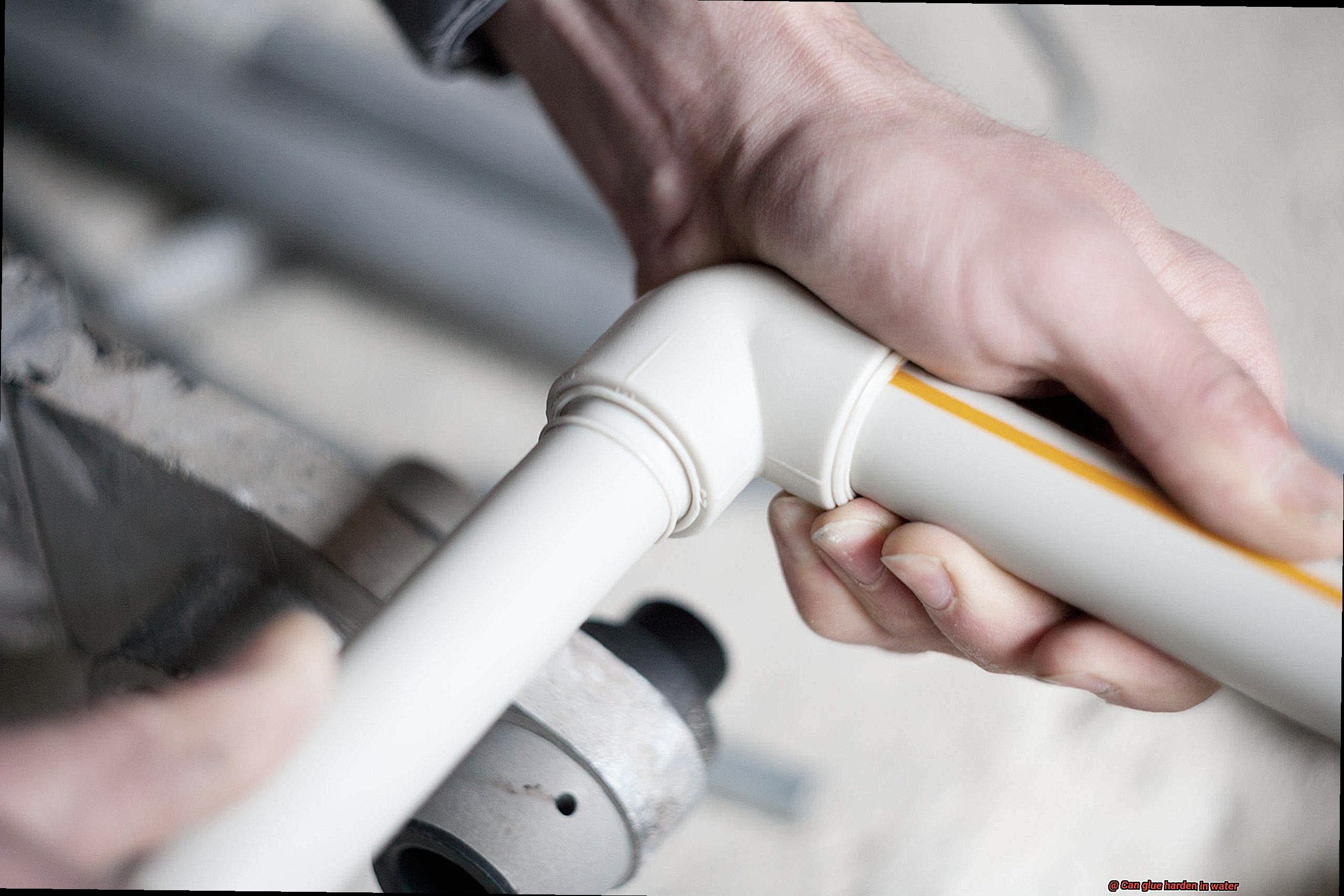
Drying and Curing Processes:
Water can also impact the drying and curing process of glue. Many glues require specific conditions to dry and harden effectively, but water can interfere with these processes. It may slow down solvent evaporation or hinder chemical reactions necessary for curing, resulting in extended drying times or incomplete hardening.
Types of Glues and Their Different Properties
Let’s explore the different types of glues and discover their unique characteristics. From water-based glues that don’t harden in water to epoxy glues that thrive underwater, each type has its own special powers.
Water-Based Glues
These glues contain water as their primary solvent and are non-toxic and easy to clean up. Perfect for crafts, bookbinding, and woodworking, water-based glues maintain their stickiness even when exposed to moisture. They form a strong bond when the water evaporates, leaving behind a solid adhesive layer. So, don’t worry about your creations falling apart in the rain.
PVA Glue (Polyvinyl Acetate)
This water-based glue is a superstar in the arts and crafts world. With strong adhesion and versatility, PVA glue doesn’t harden in water either. It retains its bond strength even when things get a little wet. So, go ahead and use it on projects that might come into contact with water.
Epoxy Glue
Prepare to be amazed by this two-part adhesive. Epoxy consists of resin and hardener that, when mixed together, create a super-strong bond. And guess what? Epoxy glues are resistant to water. They can harden underwater or in damp environments. That’s why they’re used in construction, automotive, and marine industries where waterproof properties are key.
Super Glue (Cyanoacrylate)
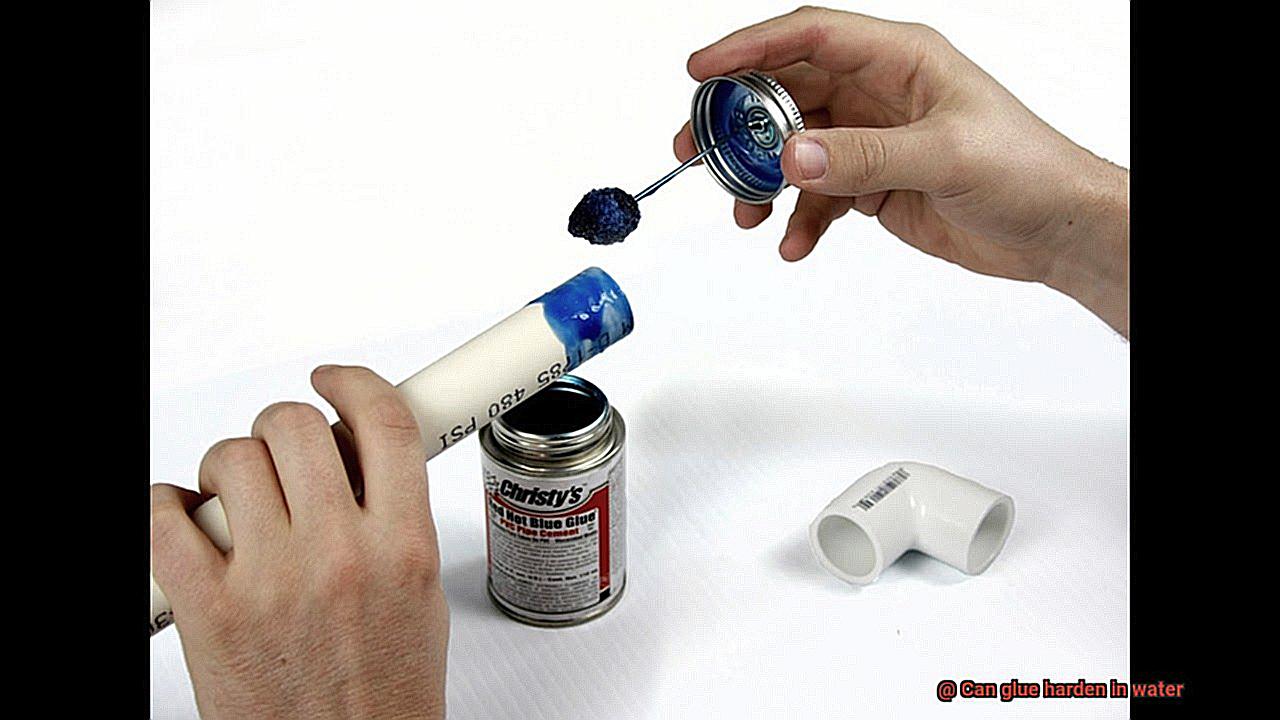
Meet the fast-acting adhesive that bonds quickly and strongly to various materials. While super glue can harden in the presence of water, too much moisture can mess with its curing process. So, make sure to dry those surfaces before applying it.
Hot Glue
It’s like molten magic. When heated, this thermoplastic adhesive becomes a liquid and solidifies as it cools down. But here’s the catch – hot glue is not water-resistant. It can soften or even melt when exposed to water or high humidity. So, keep it away from water-related projects.
Silicone Sealant
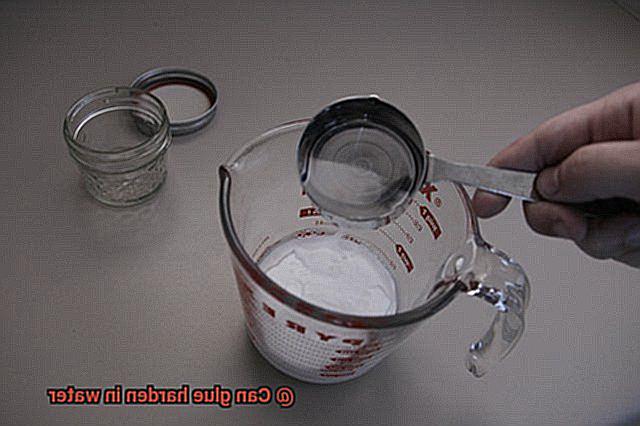
Perfect for sealing joints and gaps, silicone sealant cures in the presence of water or moisture, forming a waterproof and durable seal.
Water-Resistant Glues: What Are They and How Do They Work?
Join me as we dive into the world of these incredible adhesives. From hydrophobic heroes to the dance of intermolecular forces, let’s explore the secret mechanisms behind water-resistant glues.
Hydrophobic Heroes:
Water-resistant glues possess a remarkable ability to repel water, thanks to hydrophobic compounds like silicone or wax. These additives create a protective barrier, like tiny superheroes standing guard, shielding your bond from water’s relentless advances.
The Power of Cross-Linking:
To maintain their adhesive properties even in damp conditions, water-resistant glues incorporate cross-linking agents. These agents form chemical bonds with the adhesive molecules, creating a three-dimensional network. This structure enhances the glue’s resistance to moisture and keeps your project intact under the toughest wet conditions.
The Dance of Intermolecular Forces:
When water challenges the bond created by water-resistant glue, it encounters a formidable opponent. The chemical additives in these glues interact with the surface materials, creating intermolecular forces that hold the bond together. Water forms droplets that slide off effortlessly, unable to break the adhesive spell.
Conclusion:
Water-resistant glues are marvels of chemistry, allowing us to build and create with confidence even in wet environments. By harnessing hydrophobic compounds and employing cross-linking agents, these glues repel water while maintaining their adhesive strength. Although they aren’t invincible against all forms of moisture, understanding their characteristics and using them appropriately ensures maximum performance.
Advantages of Using Water-Resistant Glues
Water-resistant glues offer a range of advantages that make them a superior choice over traditional glues when it comes to bonding materials in wet or humid environments. Let’s dive right into the advantages of using water-resistant glues:
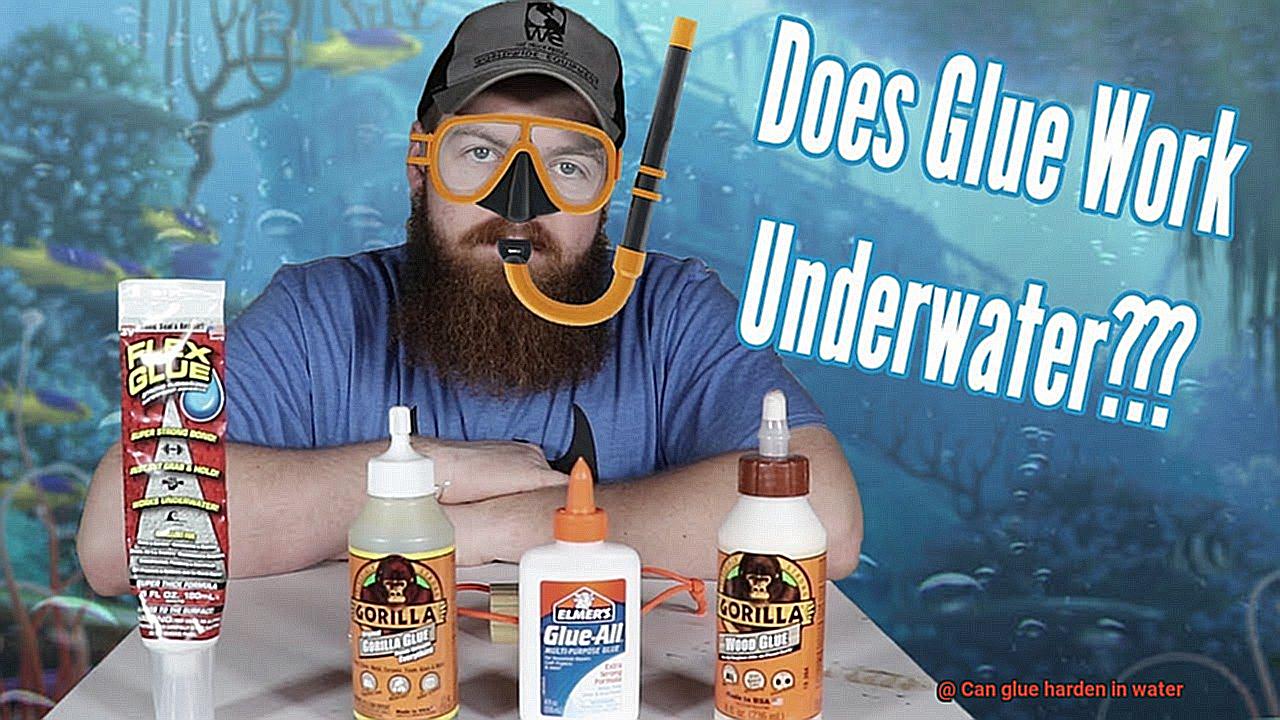
- Increased Durability: Water-resistant glues are specifically formulated to withstand exposure to water, moisture, and humidity without losing their adhesive properties. This means that the bonds they create are long-lasting and can withstand the test of time. Whether you’re working on an outdoor project or need to repair items that frequently come into contact with water, water-resistant glues will ensure your creations stay intact.
- Versatile Application: What’s great about water-resistant glues is that they can be used on a wide range of materials, including wood, metal, plastic, and ceramics. This versatility makes them ideal for various projects and applications. So whether you’re fixing a broken chair or creating a masterpiece out of different materials, water-resistant glues have got you covered.
- Enhanced Performance in Wet Environments: Unlike traditional glues that may lose their adhesive strength when exposed to water or moisture, water-resistant glues maintain their bonding capabilities even in wet environments. This makes them perfect for applications where the glued materials may be subjected to frequent wetting or immersion, such as marine installations or bathroom repairs.
- Resistance to Mold and Mildew: Traditional glues that are not water-resistant can create a breeding ground for mold and mildew growth, especially in damp or humid conditions. However, by using water-resistant glues, you can minimize the risk of mold or mildew formation on the bonded surfaces. This not only ensures a cleaner and healthier environment but also prolongs the life of your glued items.
- Ease of Use: Water-resistant glues are designed to be user-friendly. They often come in convenient forms like squeeze bottles or tubes with applicator tips, making application precise and hassle-free. No need for additional tools or equipment – simply grab your water-resistant glue and get to work.
- Wide Availability: Another advantage of water-resistant glues is their wide availability in the market. You can find them in hardware stores, home improvement centers, and even online retailers. With a variety of brands and types to choose from, you can easily find the perfect water-resistant glue for your specific needs.
Disadvantages of Using Water-Resistant Glues
Water-resistant glues may offer the promise of durability and resistance to moisture, but they also come with their fair share of disadvantages. In this section, we will explore the drawbacks associated with the use of these glues, shedding light on the potential pitfalls that users should be aware of.
One significant disadvantage of water-resistant glues is their higher cost compared to regular glues. The additional chemical formulations and complex manufacturing processes required to make them water-resistant contribute to their increased price tag. This can pose a significant drawback for individuals or businesses operating on a tight budget.
Another downside is the longer drying or curing time. Unlike regular glues that quickly bond materials together, water-resistant glues often require extended periods to dry thoroughly. This can prove inconvenient when working on time-sensitive projects or situations where immediate bonding is crucial. The prolonged drying time can lead to potential setbacks and frustrations, delaying completion.
Additionally, removing water-resistant glues can be challenging. Once these glues dry and harden, they form an unyielding bond that resists water penetration. Consequently, attempting to remove or reposition glued objects becomes an arduous task. This difficulty in removal poses problems when making repairs or modifications, as it necessitates additional effort and may potentially damage the materials being worked on.
Moreover, some water-resistant glues emit strong odors during the drying process. These odors can be not only unpleasant but also potentially harmful if inhaled in large quantities or in enclosed spaces. Ensuring proper ventilation and taking necessary precautions when working with such glues is vital to safeguard one’s health.
In certain applications, water-resistant glues may not provide the desired level of adhesion strength. Although they are designed to resist water, their ability to adhere strongly to certain materials or surfaces may fall short when compared to specialized adhesives formulated explicitly for those substrates. This limitation compromises the overall durability and longevity of bonded objects, undercutting the very purpose of using water-resistant glues.
Furthermore, water-resistant glues may exhibit limited compatibility with different materials. Some glues may not bond effectively with specific types of plastics, metals, or other materials, constricting their usage in various applications. Ensuring compatibility between the glue and the materials being bonded is essential to achieve optimal results.
Finally, the environmental impact of water-resistant glues should not be overlooked. While they offer resistance to water and moisture, they may contain chemicals that are harmful to the environment. Proper disposal of these glues in accordance with local regulations is imperative to minimize any potential negative effects on ecosystems.
Tips for Choosing the Right Water-Resistant Glue
When taking on a project that involves water exposure, finding the right water-resistant glue becomes essential. With numerous options available, it can be overwhelming to make the right choice. Fear not. We have gathered expert tips to guide you through this selection process. Dive into the secret of choosing the perfect water-resistant glue for your project.
Understand the Importance of Water Resistance:
Imagine a wooden outdoor table or a bathroom tile repair job. These projects demand water-resistant glue to ensure their integrity even in wet conditions. Don’t let moisture dampen your efforts; opt for water-resistant glue to keep your projects strong and intact.
Consider the Type of Material:
Different materials require different glues. When selecting a water-resistant adhesive, consider the material you’re working with. Wood glues are formulated explicitly for bonding wood surfaces, while metal glues are designed to adhere to metals. Choose a glue compatible with your material for optimal results.
Evaluate the Level of Water Resistance Needed:
Assess the extent of water exposure your project will face. Some glues are water-resistant, adept at withstanding occasional splashes or high humidity levels. Others are waterproof, suitable for projects submerged in water or exposed to heavy rain. Understanding the required level of water resistance helps you choose the right glue for your specific project.
Read Labels and Descriptions:
Before purchasing, diligently read labels and product descriptions of different glues. Look for keywords like “water-resistant,” “waterproof,” or “marine-grade” to ensure they meet your requirements. Pay attention to any recommended application instructions or precautions to ensure proper usage.
Test Before Committing:
To ensure optimal performance, always perform a small test before applying glue to the entire project. Apply glue to a sample piece or scrap material and expose it to water or simulated moisture conditions. This test will reveal how well the glue performs and whether it meets your expectations in terms of water resistance.
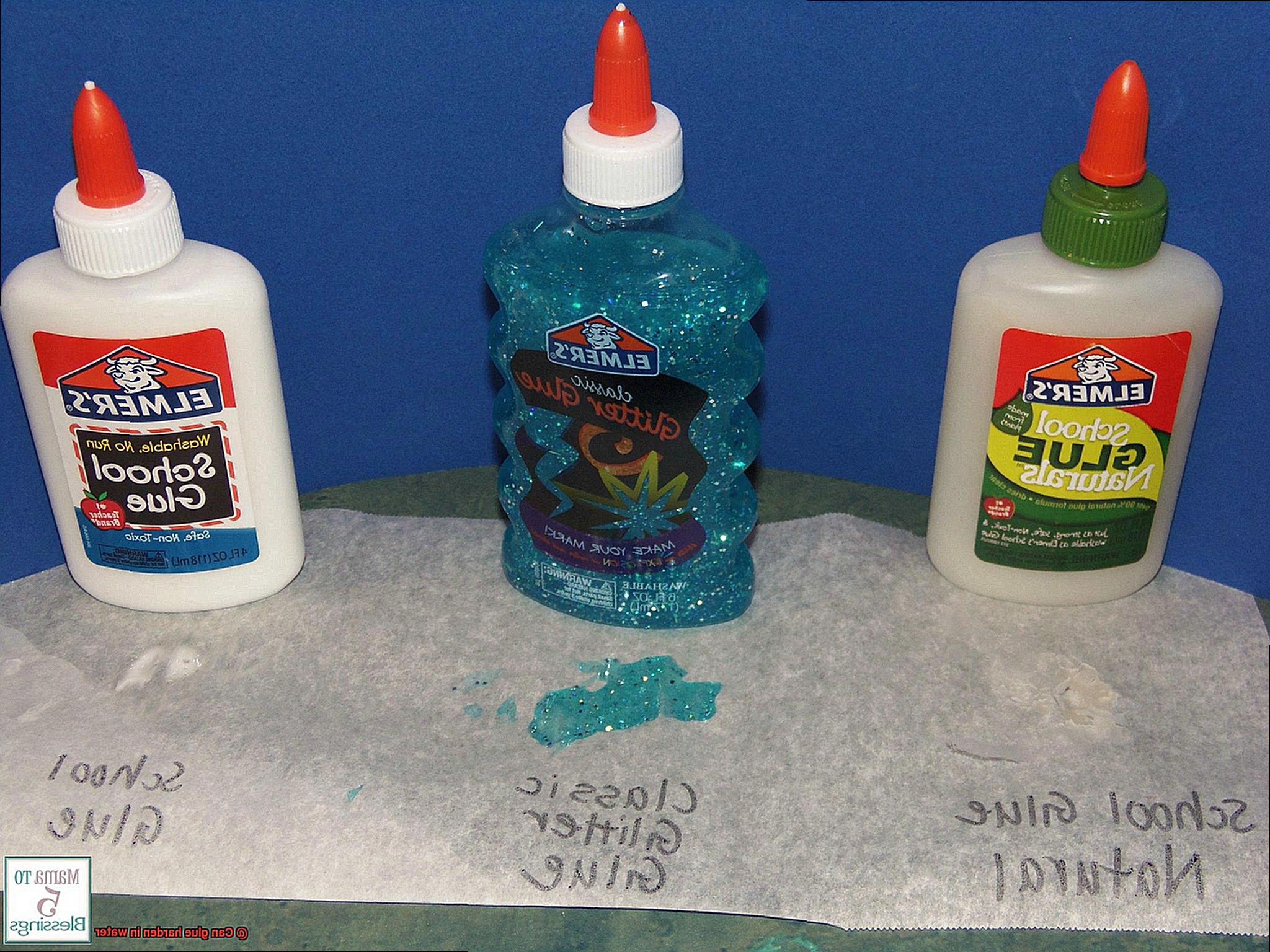
Common Uses for Water-Resistant Glue
Well, look no further, because water-resistant glue is here to save the day. This magical adhesive is specifically designed to withstand exposure to water without losing its adhesive properties or breaking down. Whether you’re in the construction, woodworking, automotive, crafting, marine, electronics, or outdoor furniture industry, water-resistant glue has got you covered.
In the construction industry, water-resistant glue is a lifesaver when it comes to bonding materials that are exposed to moisture or water. From bathroom fixtures to outdoor decking and swimming pool tiles, this glue ensures that the bond remains strong even when subjected to constant water exposure.
Woodworkers rejoice. Water-resistant glue is your go-to adhesive for joining wood pieces together. No more worries about your beautifully crafted projects warping or falling apart due to water absorption. This glue will keep your woodwork intact even in humid or moist environments.
The automotive industry also benefits greatly from water-resistant glue. It’s perfect for bonding materials used in car interiors such as upholstery, carpets, and trim. Spills and exposure to moisture are no match for this adhesive, ensuring that everything stays in place even if they come into contact with water.
If you’re a crafting enthusiast or a DIY lover, water-resistant glue is a must-have for your outdoor projects. Whether you’re working with ceramic, glass, plastic, or metal, this glue will keep your creations intact even in rainy weather.
Ahoy there. In the marine industry, water-resistant glue is a lifesaver for boat repairs and maintenance. It can withstand the constant exposure to water and harsh marine environments without losing its adhesive power. From repairing fiberglass hulls to securing marine accessories, this glue will keep everything shipshape.
Electronics and electrical engineers also rely on water-resistant glue for their projects. It can be used for bonding components or sealing connections in devices that may be exposed to moisture or water. Outdoor lighting fixtures and underwater sensors are just a few examples of where this glue comes in handy.
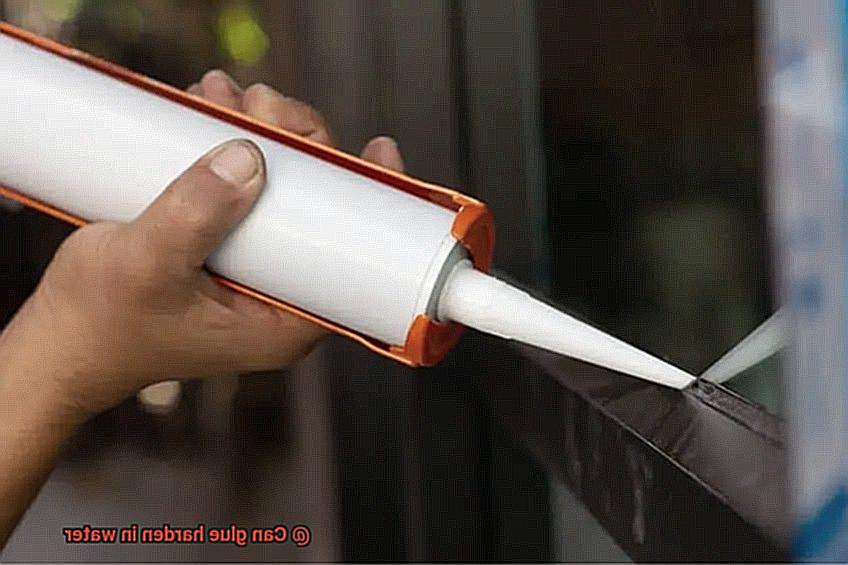
Last but not least, water-resistant glue is a crucial component in the manufacturing of outdoor furniture. It ensures a strong bond for materials such as wicker, rattan, or metal, allowing your furniture to withstand the elements without deteriorating.
So, whether you’re building, crafting, repairing, or manufacturing, water-resistant glue is your secret weapon against water damage. Say goodbye to projects falling apart at the first sign of rain and hello to long-lasting durability. Choose water-resistant glue and let your creations stand strong even in wet conditions.
Safety Precautions When Working with Water-Resistant Glue

One type of glue that stands out due to its unique properties is water-resistant glue. It’s a versatile adhesive that can withstand moisture and provide long-lasting bonds in various applications. However, it’s important to remember that safety should always be a priority when working with any type of glue. In this blog post, we’ll discuss some essential safety precautions to take when using water-resistant glue.
Wear Protective Gloves:
First and foremost, always wear protective gloves when working with water-resistant glue. Some glues contain chemicals that can irritate or harm the skin upon contact. By wearing gloves, you provide a physical barrier between your hands and the adhesive, minimizing any potential risks.
Work in a Well-Ventilated Area:
Proper ventilation is crucial when using any type of adhesive, including water-resistant glue. Certain glues emit fumes that can be harmful if inhaled excessively or for prolonged periods. Ensure that you work in a well-ventilated area by opening windows or using fans to dissipate any fumes and maintain a safe working environment.
Use Eye Protection:
Protect your eyes by wearing safety goggles when working with water-resistant glue. Accidental splashes or drips can cause irritation or injury to your eyes. Safety goggles provide an extra layer of protection, guarding your eyes from potential harm.
Follow Manufacturer’s Instructions:
Always read and follow the manufacturer’s instructions provided with the water-resistant glue you are using. Each product may have specific safety precautions and application methods that need to be followed for optimal results and safety. Don’t overlook this step; it ensures that you’re using the glue correctly and minimizes any potential risks.
Keep Glue Away from Children and Pets:
Water-resistant glue should be stored in a secure location out of reach of children and pets. Some glues may contain toxic substances that can pose a threat if ingested or if they come into contact with sensitive individuals. Ensure that you store the glue in a place where it cannot be accessed by curious hands or paws.
Clean Up Spills Immediately:
Accidents happen, and sometimes spills occur when working with water-resistant glue. It’s crucial to clean up any spills immediately to prevent accidents or damage. Use appropriate cleaning materials and follow recommended procedures for cleaning up glue spills to maintain a safe working area.
Dispose of Glue Properly:
When it’s time to dispose of water-resistant glue containers or excess adhesive, it’s important to follow local regulations and guidelines for hazardous waste disposal. Improper disposal can have negative environmental impacts, so ensure that you dispose of the glue responsibly. Check with your local waste management facility for proper disposal methods.
uQFp4n1zCWA” >
Also Read: Is Super Glue Waterproof? – Glue Things
Conclusion
In conclusion, the question of whether glue can harden in water has been thoroughly explored. Through our research, it is clear that most common types of glue do not harden when exposed to water. Water actually weakens the bond formed by glue, preventing it from fully setting or hardening.
This phenomenon occurs because water interferes with the chemical reactions that take place during the drying process of glue. When glue is exposed to moisture, it disrupts the cross-linking of molecules, which is essential for creating a strong and durable bond.
However, it’s important to note that there are specialized waterproof glues available on the market. These glues are specifically designed to withstand exposure to water and maintain their adhesive properties even in wet conditions. They often contain additives or chemical compounds that make them resistant to moisture.
So, while regular glue may not harden in water, there are alternatives for projects that require waterproof bonding. It’s always recommended to read the label or consult with a professional when selecting a glue for specific applications.
In summary, understanding how different types of glue react to water is crucial for achieving successful and long-lasting bonding results.

